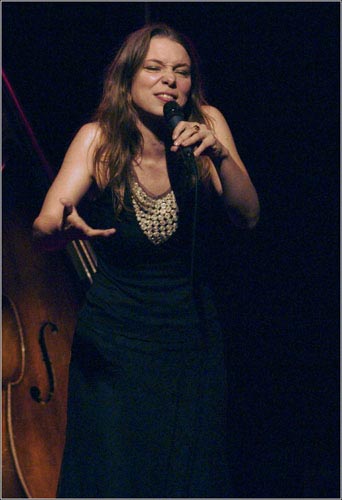|
|
|
Lhasa de Sela
|
| October 23, 2004 • The Royal Wintergarden • Toronto |
|
|
| This sophisticated young performer with the persona of a longhaired Alice-in- Wonderland and the husky voice of a postmenopausal woman sings her own songs in a way that will haunt you like a secret.
During her introductions at the performance at the Wintergarden in Toronto, Saturday, October 23 with her quintet, Lhasa de Sela speaks in a halting hushed little girl voice. During a song, her voice comes out straight, no vibrato, in command of an extraordinary range of textures.
|
It is as if Lhasa were a painter who did not confine herself to fine brushstrokes, but also employed thick daubs of palette knife, rubs of pastel stick, splashes from a can, squirts from a tube and long, slow drips.
Emotion, which she controls, modulates the textures of her voice. Her palette of vocal textures and their application is the principle tool by which she gains her distinctive effects.
Her baseline approach to song is the talking-style delivery of the European chanson which intensifies into passages of more lyric singing, depending on the shifts among her emotional personae.
This remarkable repertoire of vocal textures ranges from an intimate whisper to firmer textures of speaking voice conveying degrees of intimacy. When her voice rises in pitch, the thin catgut tones indicate fragility stretched from the point of tautness to breaking.
When her pitch falls, as it can, from phrase to phrase in the same verse, and the breathiness solidifies into a more textured surface, her range can come out of a Dietrich-like seductiveness that may modulate in a flicker to a harsh, agonized groan, to a shout of pain, a savage yell.
|
|
 |
|
All very low key. The drama is in the contrast, nuanced or bold, not in the volume.
Lhasa’s delivery is chant-like, the phrases short, repetitive, mantraic, this quality is especially reinforced when she sings in Spanish with its inflected open-vowelled endings, all cumulating into an hypnotic effect over which ride the cry of the viola, the wail of the mariachi trumpet, the solitary declarations of flute and guitar.
The arrangements during her performance at the Wintergarden, were adventurous: – waves of electronic effects with dense rhythmic patterns and cross patterns from a huge percussion setup supported by booms from the bass, thumps, clicks, and handclaps from the cellist and the keyboard making a landscape across which her haunting melodies loped in their characteristic rhythm, the clip-clop horse-hoof walking-beat, the rhythm of the fugitive.
Lhasa's songs are about the pain of enslavement to longing and yearning and the urge towards freedom on the open road: "There is nowhere to stop/anywhere on this road."
She is very concentrated, and therefore, compelling. There is a riveting stanza in Anywhere on this Road, that dramatizes how she sees herself and her journey: "I love a man/who's afraid of me/He believes if he doesn't/ Stand guard with a knife/ I'll make him my slave/ For the rest of his life."
Beyond this kind of fixation on "longing and yearning" is the road, where, she sings, "If I can stand up/To angels and men/I'll never get swallowed/In darkness again."
Walk on.
|
|
|
|
Report and Photograph by Stanley Fefferman
|
|
|
|
|


